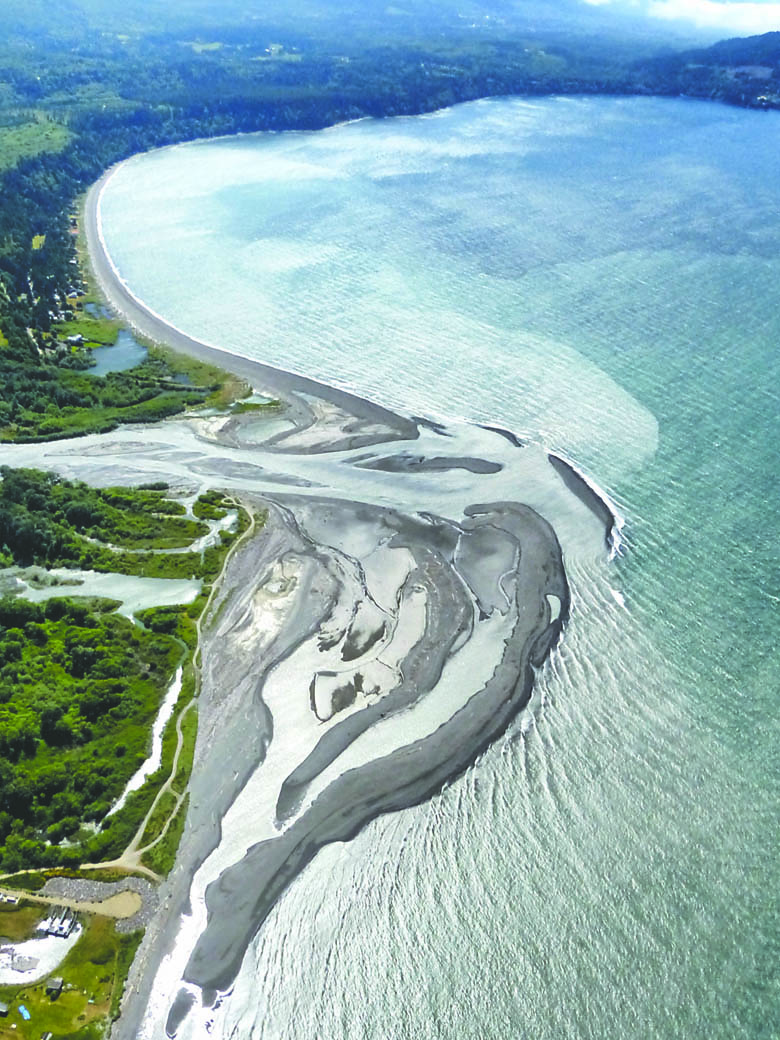OLYMPIC NATIONAL PARK — The once-towering Glines Canyon Dam’s days are numbered.
The final 30 feet of the concrete goliath, which once stood 210 feet tall along the Elwha River, are expected to be gone by this fall as the dam removal portion of the $325 million Elwha River restoration project prepares to draw to a close.
Park contractor Barnard Construction Co. Inc. cannot blast any more of the dam remnant during predetermined fish-spawning periods, known as “fish windows,” or when the Elwha’s flow exceeds 1,100 cubic feet per second, or cfs, said Barb Maynes, Olympic National Park spokeswoman.
The current fish window, in place to protect spawning fish in the river, ends July 1, Maynes said, with another set between the beginning of August and the first half of September.
Crews need river flows between 1,000 and 1,100 cfs to be able to access the remaining bottom portion of the dam, Maynes said; otherwise, it will be underwater.
“They just need for the river to drop,” she said.
She estimated that two or three individual blasts will be needed to remove the lingering 30 feet.
Glines viewpoints
Once demolition is finished, Maynes said, park staff will begin work installing fences around the remaining top-most portions of Glines Canyon Dam so they can be used as visitor viewpoints.
Removal of the Glines Canyon and Elwha dams began in September 2011 as the centerpiece of the Elwha River restoration effort.
The century-old Elwha Dam near state Highway 112 west of Port Angeles was removed by March 2012.
Both dams were built without fish ladders and for decades locked up miles of fish-spawning habitat.
The project also includes monitoring several species of salmon and steelhead trout as they return to the river and studying the impacts of millions of cubic yards of sediment once locked behind the dams as it’s released into the Strait of Juan de Fuca.
Fish nests counted
This spring, fish biologists counted 24 steelhead trout nests, or redds, in tributaries of the Elwha upstream from the former site of Elwha Dam, Maynes said.
Counts completed last fall logged 3,528 adult chinook seen in the river and its tributaries between the remnants of Glines Canyon Dam and the Strait of Juan de Fuca, according to park officials.
“It is continued good news that fish are returning and returning to new areas and reaching areas on their own that have been closed off for decades,” Maynes said.
Pat Crain, a fisheries biologist with the national park, said this past spring is the first time steelhead redds have been seen in river tributaries other than Little River and Indian Creek.
No counts of individual steelhead have been completed yet this year, he added.
Crain said park biologists have spent the past few weeks capturing steelhead and tagging them with radio transmitters so their movements can be tracked as they make their way up the river.
“This is the first effort, now that the dams are out, to do a major tagging operation and track fish,” he said.
The number of fish and redds seen so far and the timing of fish returning have roughly tracked with predictions made before the project began, he added.
“I think we’re on track, definitely moving toward recovery,” he said.
Mouth of Elwha
Somewhat below expectations, however, is the amount of sediment deposited at the ever-changing mouth of the Elwha between last September and April, said Ian Miller, a coastal hazards specialist with Washington Sea Grant.
A spring survey of the mouth in collaboration with scientists from the U.S. Geological Survey found about 392,000 cubic yards of sediment had been added to the mouth since fall, Miller said.
“I was expecting quite a bit more,” he said.
Between November 2012 and September 2013, about 3.3 million cubic yards of sediment once locked behind the two massive dams built up at the Elwha’s mouth, forming new beaches where once there were only the azure waters of the Strait.
Miller said he has seen the river’s maw change in recent months from a few large channels of water flowing into the Strait to dozens and dozens of smaller ones braided across the new beaches.
“[The channels] change daily in response to the river pushing material out and waves [from the Strait],” Miller said.
Millions of cubic yards of sediment have been released from the bottom of the lakes that once bore the names Aldwell and Mills.
________
Reporter Jeremy Schwartz can be reached at 360-452-2345, ext. 5074, or at jschwartz@peninsuladailynews.com.

